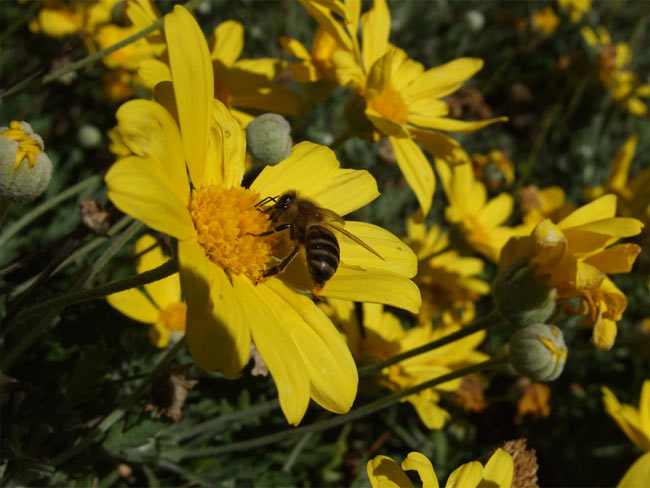Bees Know Their Numbers

While honeybees might not take home any math awards, new research reveals the social insects can grasp numbers, telling the difference between two, three and four dots.
Higher than that, the bees' calculators seem to go kaput in experiments. The honeybees couldn't reliably distinguish between four dots and five or six.
In the lab experiments, Shaowu Zhang of the Australian National University and his colleagues had honeybees (Apis mellifera) fly through an entrance of a Y-maze marked with a pattern of either two or three dots, which were signposts to a reward. Farther into the maze at a sort of "fork in the road," the bees had to choose between two patterns by correctly matching the number of dots. So if a bee began through a two-dot entrance, the bee would then have to choose the two-dot pattern over a three-dot one to locate a sugar-water reward.
After a bit of schooling, the bees were successful at the feat of distinguishing two and three dots about 80 percent of the time. And while the bees could pick out the three-item pattern from four about 70 percent of the time, they didn't consistently do four-to-four matches when paired with three, five or six-item patterns.
It might be a stretch to say the bees were counting, but in some ways, they weren't easily fooled. Even when the researchers changed the pattern, shape or color of the dots, the bees still managed to distinguish between the different numbers of items, suggesting the bees weren't relying on their other senses to find the treat.
"Bees can definitely recognize the difference between two, three and four, although four a little less reliably," Zhang said. "This is a process known as ''subitizing,' which means responding rapidly to a small number of items."
This subitizing limit of four is similar to what has been found in humans, according to study researcher Jürgen Tautz of the BEEgroup, Biocenter, University of Würzburg, in Germany. For example, if you walked into a parking lot and saw a group of two, three or four cars, you would immediately know the number of cars without having to stop and count them. That flash of knowing would involve subitizing.
Sign up for the Live Science daily newsletter now
Get the world’s most fascinating discoveries delivered straight to your inbox.
The limit has other practical implications: "How do you keep track when you do handwritten lists? You make maximally four vertical lines, and then you cross them with the fifth one," Tautz told LiveScience.
For bees, this ability to discriminate between small numbers likely helps the insects to navigate in the wild where they can travel over distances as great as 6.8 miles (11 km) to a food source, and then find their way back to the hive and out again later to the same spot, Zhang said. So along the way, the bees might navigate by distinguishing between, say, clumps of two trees versus three trees or other natural landmarks, Zhang said.
Next, the researchers hope to run experiments to figure out whether the bees can actually perform elementary arithmetic such as adding.
The results are published in the Jan. 28 issue of the online journal PLoS ONE.
- Monkeys Do Math Like Humans
- Honeybees Can Learn Foreign 'Languages'
- Images: Backyard Bugs
Jeanna Bryner is managing editor of Scientific American. Previously she was editor in chief of Live Science and, prior to that, an editor at Scholastic's Science World magazine. Bryner has an English degree from Salisbury University, a master's degree in biogeochemistry and environmental sciences from the University of Maryland and a graduate science journalism degree from New York University. She has worked as a biologist in Florida, where she monitored wetlands and did field surveys for endangered species, including the gorgeous Florida Scrub Jay. She also received an ocean sciences journalism fellowship from the Woods Hole Oceanographic Institution. She is a firm believer that science is for everyone and that just about everything can be viewed through the lens of science.









